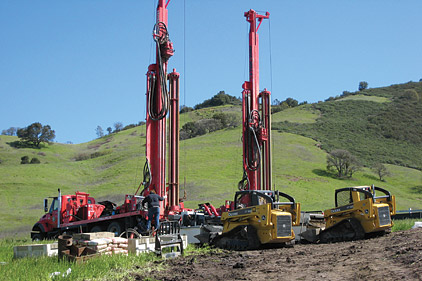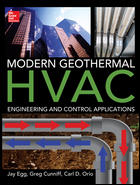The climates simulated in the greenhouses are hot and humid, humid intermediate, dry intermediate, and cool. “Every orchid has its own specific needs. That’s part of the challenge,” said Denis Roessiger, who founded the farm in 1993. “Mother Nature is tough to replicate. It requires a lot of homework to figure out what makes them happy.”
Roessiger built the polycarbonate greenhouses — which range from 360 to 912 square feet — in 2001 when he switched from growing annuals to orchids. Prior to 2010, Roessiger relied on inefficient old furnaces and tens of thousands of gallons of fuel oil a year with propane backup heat for all of his greenhouses. It was the combination of ever-rising fuel prices and the desire to do his part for the environment that led him to switch to geothermal.
The greenhouse re-greening called for a master plan. Roessiger started with a phone call to ELCO Geothermal, Bangor, Maine. ELCO began the job on a frigid January day in 2010. Because of the rocky soil, shallow ledge, and good steady aquifer at the location for the first geothermal system, Jared True, project manager, ELCO, decided an open loop, vertically-bored, water-to-air geothermal system was best for the warm and intermediate greenhouses.
Thermostats on the back-up oil forced air system are kept three degrees below the geo system’s set point. If the power goes out, the generator-charged oil system provides the needed Btuh.
Let’s Do More
Once Roessiger saw how well the ClimateMaster Tranquility 27 geothermal system worked within his first two greenhouses and the savings that accompanied it, he called ELCO back the following summer. It was time to switch the remaining greenhouses to geo.
Because he had plenty of wooded land near the humid and semi-humid greenhouses, Roessiger cleared an acre of hardpan clay to prepare for the horizontal closed loops feeding 16 trenches, 6 feet deep and 175 feet long. The geoexchange field is connected to more ClimateMaster Tranquility 27 models with two-stage compressors.
Roessiger’s satisfaction with ELCO’s work led to yet another call to Jared True; this time, he wanted to tackle his home’s heating system. His 2,400-square-foot, two-bedroom home is a post and beam beauty with a SIPS (structurally insulated panels) outer shell. The structure called for a vertical closed loop, 5-ton, ClimateMaster TMW Tranquility water-to-water unit, which is now tied-in as the primary source of heat for an extensive, in-floor radiant heat system. It also serves the Bradford White water heater, which meets domestic water heating needs.
The existing radiant was previously heated by a 125,000 MBtuh Viessmann boiler, which is now used as a back-up heat source. Due to the heat pump scroll compressor’s momentary high “locked rotor amps” (LRA) start-up spike, it made sense to let the existing stand-by generator power the home and boiler, but not the geothermal heat pump, explained True. “This way, if there’s a power outage, the generator is automatically started and will power up the boiler to satisfy any call for heat or domestic hot water.”
This project used a primary/secondary loop piping arrangement. The geothermal system, which uses an 80-gallon stone lined accumulator tank, is tied into the piping system after the primary loop. “This allows us to bypass the mixing valves required on the oil boiler system — to mix boiler water from 180˚ to 110˚F,” said True. “The geothermal accumulator tank temperature is maintained between 105˚ and 115˚.”
Roessiger’s now-enhanced system includes several Taco circulator pumps ranging in size from 007 to 0010 and a six-zone Taco switching relay. When any one of the six thermostats calls for heat, the appropriate circulator is activated.
A Watts fill valve, pressure regulator, and relief valve regulate make-up water to the hydronic system, maintaining a preset pressure while any air entering with make-up water is quickly extracted by the Taco air separator. Watts ball valves, generously installed, and boiler drains allow the technician to easily isolate sections of the system for maintenance.
“Roessiger now experiences a 60 percent savings each year in comparison to the volume of fuel oil he burned in the past,” explained True. “He can expect a complete payback within four to seven years based on today’s fuel price of $3.79/gallon. In my way of thinking, that’s an outstanding investment. Maybe now the Roessigers will have more funds on hand to buy that next greenhouse.”
Publication date: 7/23/2012






